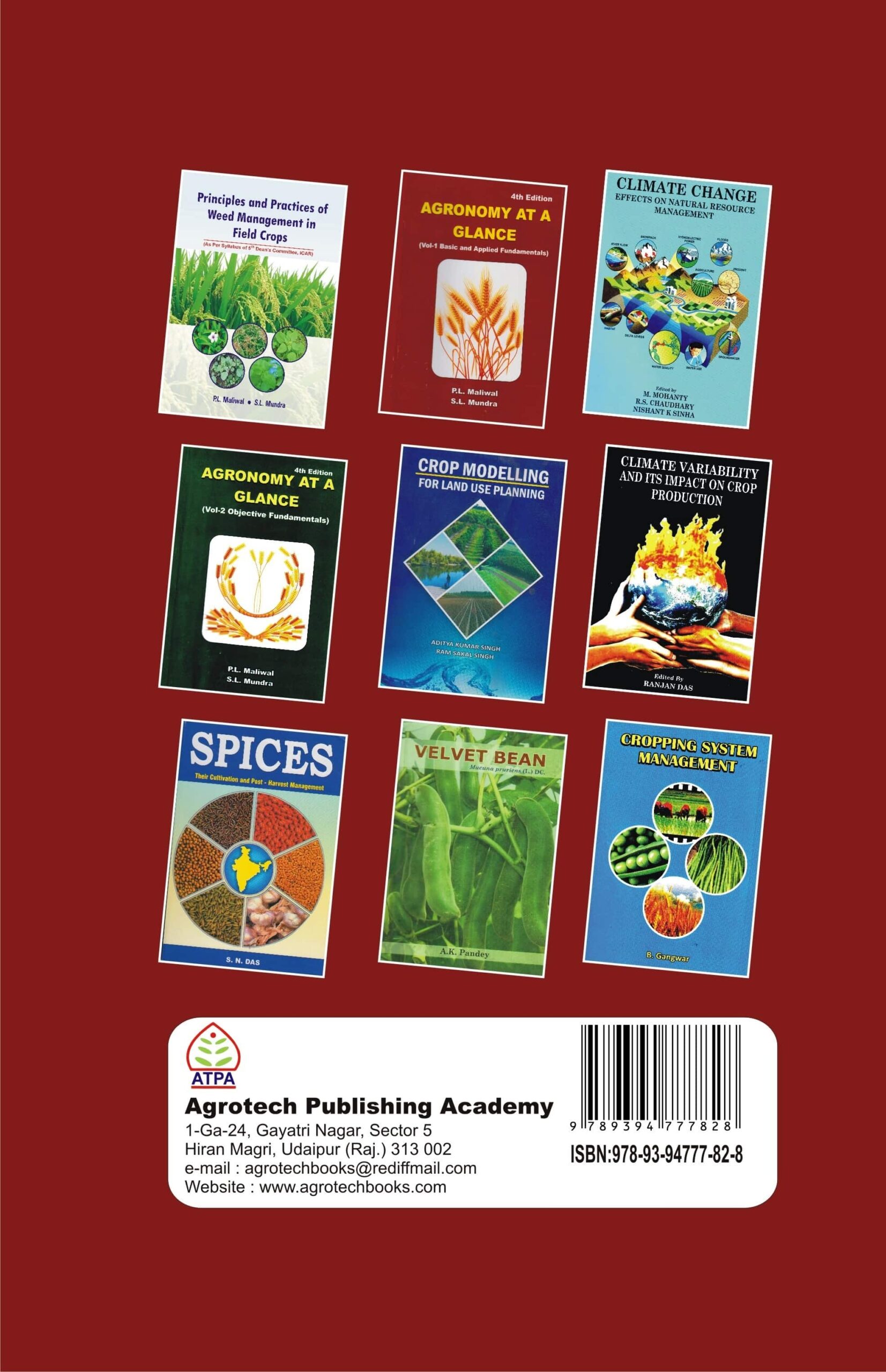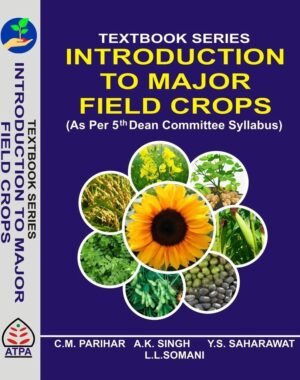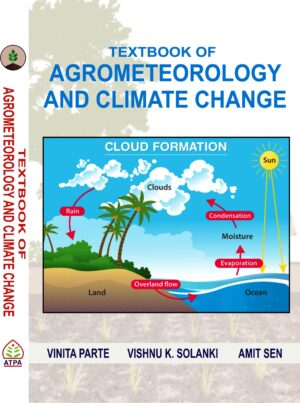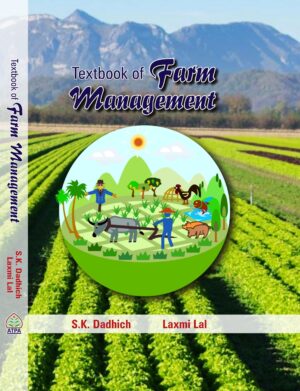TEXTBOOK OF WEED MANAGEMENT IN HORTICULTURAL CROPS
₹1,089.00
AUTHORS: P.L. MALIWAL AND S.L. MUNDRA
PUBLISHING YEAR: 2023
EDITION: 2nd
ISBN: 9789394777828
© All Rights Reserved
Description
ABOUT THE BOOK
The book “Weed Management in Horticultural Crops” has been written in a very simple and lucid language with suitable examples wherever applicable for better understanding of readers. The book consists of 19 chapters including biology and ecology of weeds, principles and concepts of weed management, methods of weed control, herbicide classification, mode of action of herbicides, herbicide selectivity, herbicide resistance in weeds, absorption and translocation of herbicides, herbicide transformation in plants, fate and persistence of herbicides in soils, adjuvants and their use, herbicide interaction with other chemicals, weed management in horticultural crops and management of problematic and aquatic weeds. In addition to these the book also includes glossary of important terms related to weed control and important information pertaining to weed management in appendices. The book is written to fulfill the requirement of under graduate students of agriculture faculty considering the syllabus of 5th Dean’s Committee of ICAR. The authors have tried their level best to clarify the very basic/fundamentals of weed science though compilation and consolidation of the facts and figures. This is the result of one strong conviction and consistent adherence to weed science research and teaching.
The student community may harvest benefit from this book by understanding the basics of weed science. We hope that this book will be very useful for the students, teachers, researchers, extension workers, and others interested in weed management.
CONTENT
Sr. No |
Title | Page No. |
| Foreword | 3 | |
| Preface | 4 | |
| About the Book | 5 | |
| About the Author | 6 | |
| 1
1.1 1.2 1.3 |
Introduction
Definition of Weed Harmful Effects of Weeds Benefits/Uses of Weeds |
11-16
11 12 15 |
| 2
2.1 2.2 2.3 2.4 2.5 2.6 2.7 |
Classification of Weeds
Based on Life Cycle /Ontogeny of Weeds Based on Morphology of Weeds Based on Association Based on Ecology and Habitat Based on Origin of Weeds Based on Weed Preference to Soil Reation Based on Plant Community |
17-21
17 19 19 20 20 21 21 |
| 3
3.1 3.2 3.3 |
Propagation and Dispersal of Weeds
Propagation of Weeds Dispersal(Dissemination) of Weeds Persistence of Weeds |
22-27
22 23 25 |
| 4
4.1 4.2 4.3 4.4 |
Crop Weed Interaction
Weed- Crop Competition Weed- Crop Interference Critical Period of Weed Crop Competition Allelopathy |
28-34
28 30 30 31 |
| 5
5.1 5.2 |
Principles and Concepts of Weed Management
Principles Concepts |
35-38
35 36 |
| 6
6.1 6.2 6.3 6.4 6.5 |
Methods of Weed Control
Crop Husbandry or Cultural Methods Physical or Mechanical Methods Chemical /Herbicidal Methods Biological Methods Integrated Weed Management (IWM) |
39-58
39 41 45 50 55 |
| 7
7.1 7.2 7.3 7.4 7.5 7.6 7.7 7.8 7.9 7.10 7.11 |
Classification of Herbicides
Based on Time of Application Based on Selectivity Based on Spectrum of Weed Control Based on Soil / Foliage Active Herbicides Based on Mode of Action Based on Residual Action in Soil Based on Duration of Weed Control Based on Chemical Structure Based on herbicide Formulation Based on Method of Appliocation Based on window of application |
59-65
59 60 60 60 61 61 62 63 63 64 65 |
| 8
8.1 8.2 8.3 |
Herbicide Application
Herbicide Application Equipments Spray Calibration and Herbicide Calculations Precautions |
66-77
66 73 76 |
| 9
9.1 9.2 9.3 |
Absoption and Translocation of Herbicides in Plants
Absorption Translocation Factors Affecting Absorption and Translocation of Herbicides |
78-83
78 80 82 |
| 10
10.1 10.2 10.3 10.4 10.5 10.6 10.7 10.8 10.9 10.10 |
Mode of Action of Herbicides
Growth Regulators Type of Herbicides Cell Membrane Disrupters Inhibitors of Amino Acid Synthesis Lipid Biosynthesis Inhibitors Pigment Inhibitors Growth Inhibitors of Shoots Herbicides with Disrupt Cell Division Inhibitors of Photosynthesis Respiration Inhibitors Primary Biochemical Modes of Action |
84-88
84 85 85 85 85 85 86 86 86 86 |
| 11
11.1 11.2 11.3 11.4 11.5 11.6 |
Herbicide Selectivity
Differential Absorption of Herbicides Differential Translocation of Herbicides Diifferential Rates of Deactivation of Herbicides Differential Protoplasmic Resistance Multifactor Herbicide Selectivity Induced Selectivity |
89-94
89 90 90 91 92 93 |
| 12
12.1 12.2 12.3 12.4 12.5 |
Herbicide Resistence in Weeds
Types of Herbicide Resistence Factors for Herbicide Resistence in Weeds Herbicide Resistance Mechanism Herbicide Resistence Management Herbicide Resistant/Tolerant Crops (HRCs/HTCs) |
95-99
95 96 97 98 98 |
| 13
13.1 |
Herbicide Transformation in Plants
Pathways of Herbicide Degradation/ Metabolisim |
100-104
100 |
| 14
14.1 14.2 14.3 14.4 |
Fate and Persistence of Herbicide in Soils
Transfer/Physical Removal Decomposition Reduce Herbicide Persistence(Residues) in Soils Herbicide Residue Estimation |
105-115
106 110 112
114 |
| 15
15.1 15.2 |
Adjuvants and Their Use
Utility of Adjuvants Kinds of Adjuvants |
116-121
116 116 |
| 16
16.1 |
Herbicide Interaction with Enviorment and Agro- Chemicals
Interactions |
122-126
123 |
| 17
17.1 17.2 17.3 17.4 |
Predominant Weeds in Horticultural Crops
Fruit Crops Vegetable Crops Plantation Crops Spices, Medicinal & Aromatic Plants |
127-148
127 131 135 137 |
| 18
18.1 18.2 18.3 18.4 18.5 18.6 18.7 18.8 18.9 |
Weed Management in Horticultural Crops
Fruit Crops/ Orchards Plantation Crops Seed Spices Medicinal and Aromatic Crops Vegetables Tuber Crops Spices Lawns & Turfs Use Of Herbicides in Different Horticultural Crops (at a Glance) |
149-169
149 154 155 156 157 160 161 162 163 |
| 19
19.1 |
Problematic Weeds and Their Management
Management Practices for Control of Problematic Weeds |
170-178
170 |
| 20 | Aquatic Weeds and Their Management | 179-183 |
| Glossary of Terms | 184-202 | |
| Appendices : I -XI | 203-232 |
ABOUT THE AUTHORS
Dr. P.L. Maliwal did his B.Sc.(Ag.) and M.Sc.(Ag.) Agronomy from the University of Udaipur, Udaipur in 1976 and 1979, respectively. He was awarded ICAR scholarship for his under graduate studies. He obtained Ph.D. degree from Mohan Lal Sukhadia University, Udaipur specializing in the field of weed management during the year 1987. Dr. Maliwal started his career as lecturer in the field of Agronomy at University of Udaipur, Udaipur. Dr. Maliwal served in different positions like Associate Director Research, Zonal Director Research, Director Extension Education and retired as Director Research from Maharana Pratap University of Agriculture and Technology, Udaipur (Rajasthan).
Dr. Maliwal has published more than 85 research papers and technical articles in various journals and magazines of national and international repute. He has also written books entitled “Agronomy at a Glance (two volumes)”, “Agricultural Development in Rajasthan” and “Technologies for Food Security and Sustainable Agriculture”. He is also co-author of three books for vocational educational (Agriculture) students. He is the recipient of best university teacher award of MPUAT, Udaipur for the year 2001-02.
Dr. S.L. Mundra did his B.Sc.(Ag.), M.Sc. and Ph.D. (Agronomy) from Sukhadia University, Udaipur; Rajasthan Agriculture University, Bikaner and Maharana Pratap University of Agriculture and Technology, Udaipur in 1985, 1987 and 2001, respectively. He has a long service experience of over 28 years of working in teaching, research, and extension. He has published over 100 research and technical articles in different journals / magazines / newspapers of high repute. He is co-author in the book entitled “Agronomy at a Glance (two volumes)” and returns several book chapters and practical manuals. He is actively involved in guiding college students for PG and Ph.D degree. Presently he is working as Director Extension, MPUAT, Udaipur.
Additional information
| AUTHOR/AUTHORS | P. L. Maliwal, S. L. Mundra |
|---|---|
| PAGES | 232 |
| BINDING | Hard Back |
| PUBLICATION YEAR | 2023 |





